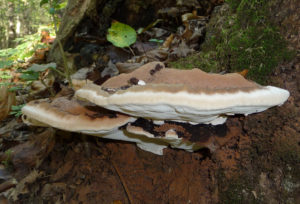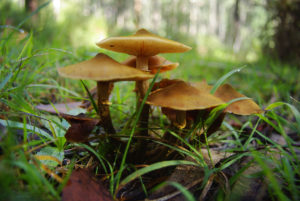Fall in Southern California doesn’t bring much in the way of crisp winds and color-changing foliage, but we can count on one reliable herald of the change in season: fungal diseases in trees.
Fungal diseases often enter trees through a wound like those caused by lawnmowers or weed wackers. If the fungal disease takes root inside the tree it can cause untold amounts of decay before any signs are visible other than mushrooms, or “fruiting bodies”. Left unchecked, fungal diseases can lead to wood rot so extensive that the entire tree may become unstable and fail.
Time for a Mushroom Hunt!
1. Ask your landscaper NOT to remove mushrooms
Instead, ask that they report them. While unsightly, these fungi give arborists crucial information about existing fungal infections and the potential degree of decay that may have resulted. These fruiting bodies are indicators of decay, NOT the cause.
2. Look for Mushrooms
During landscape walks, especially in fall, look for mushrooms at the base of your trees and on roots.
3. Call your arborist
If you find mushrooms, have your arborist take a look at them and, if necessary, make a plan for infected trees.
A Few Fungi
Ganoderma is one fungal disease that can be identified easily when fruiting bodies are present because the conks are so distinctive in appearance. They are aggressive fungi that decay the cambium layer of trees’ roots and wood, preventing cell differentiation and inhibiting vascular transport. What this means in layman’s terms is that the woody material supporting the tree becomes softened and weakened, potentially leading to the failure of the entire tree.

ganoderma applanatum
Another common tree fungus is Armillaria root rot. This fungus is somewhat more difficult to identify because its fruiting bodies look similar to lawn mushrooms. One distinctive difference in Armillaria is the pattern of black shoestring-like hairs (rhizomorphs) it creates along the tree’s buttress roots, trunk, or root collar.

armillaria luteobubalina
Prevention is the Best Cure
Unfortunately, fungal infections cannot be cured, but they can be prevented through the use of a fungicide. Talk to your tree care company about particularly susceptible trees and whether a prevention program makes sense for your property. While you’re mushroom hunting, keep your eyes peeled for situations that foster the growth of fungus:
- Trees that are planted so deeply you can’t see the root collar.
- Trees in areas that are consistently wet due to poor drainage or excessive irrigation.
- Grass or other ground cover obscuring roots or growing onto tree trunks.
- Trees in grassy areas where roots may be damaged by lawnmowers. Consider adding mulch rings around these trees.
Contact us if you have concerns about fungal diseases, decay, or anything else related to your trees.

